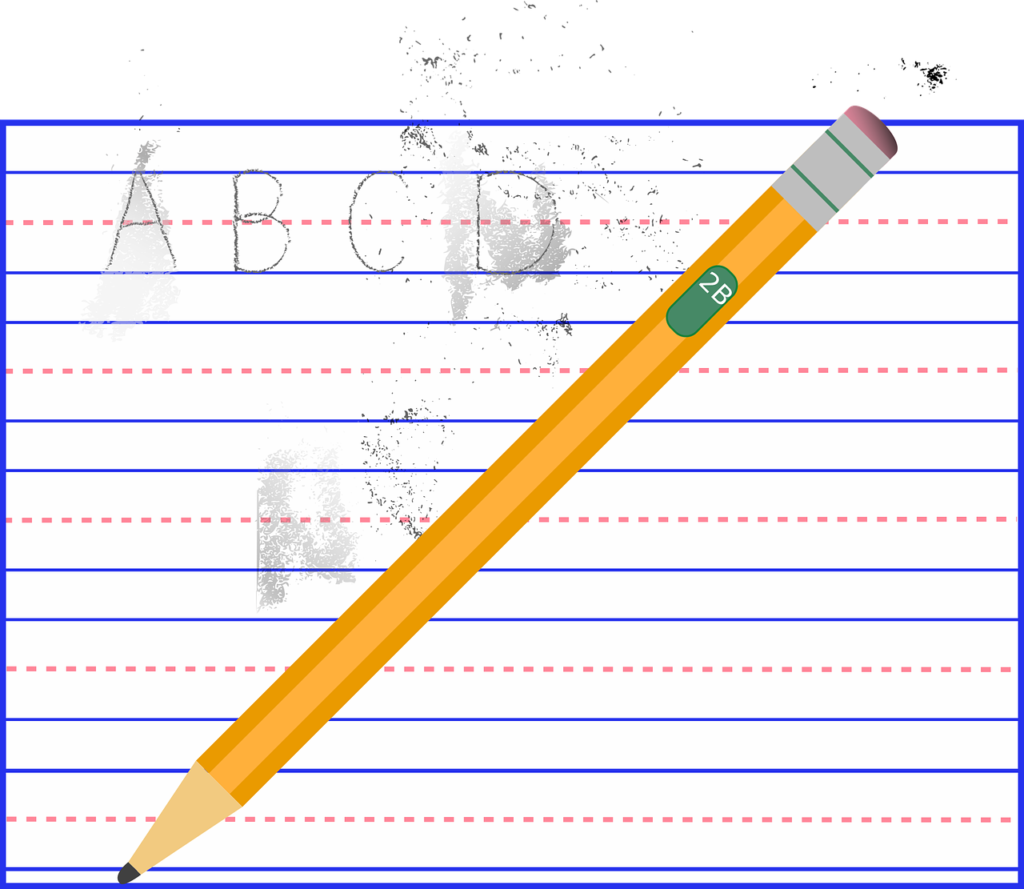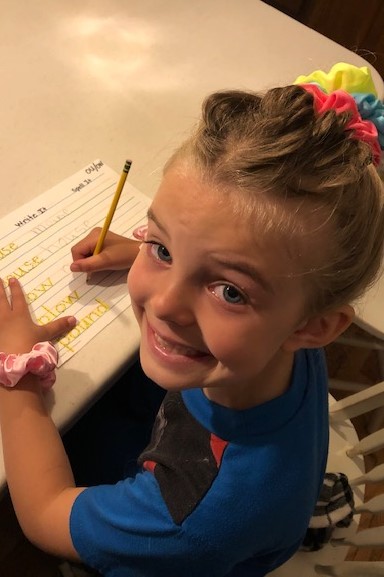
Were you one of the kids who loved or hated handwriting? I feel like you are either one or the other. I was the little girl who strived to have the neatest most “teacher-like” handwriting in the classroom. I remember my 1st grade teacher walking around the room and checking each letter that we formed in our Handwriting Book. I would just HATE when she’d mark with her red pen each spot where my pencil mark went below the bottom line. Our page was either marked up with red pen or she’d put a sticker at the top of the page! It was a really lucky day if she was passing out the smelly stickers! A red pen or a reward sticker can really make or break a kids day!
Well, a bit has changed since 1985.
Handwriting has been taken out of many elementary schools because…well…there is just not time for everything.
Many school administrators have replaced handwriting with typing apps or lessons. There are asking questions like: Is it really important to have perfectly beautiful handwriting when this generation will be doing majority of their writing on computers? It seems that educators have gotten into a routine of teaching directly to the state standards. In many states handwriting is barely mentioned in the state standards. Some states simply require legible handwriting. For this reason, many schools have pushed handwriting aside to create more time for the other learning standards that are more easily measured or that will show up on a test.
I guess handwriting is a bit like fashion. after about 30 years it makes a comeback!
That’s right, scrunchies aren’t the only thing making a come back.
It’s time we consider the benefits of handwriting and bring it back to the classroom!
The Power of Teaching Handwriting
Why teach handwriting?
Research shows that there are many benefits of teaching students in elementary school, both manuscript and cursive handwriting. We are learning that teaching proper handwriting will develop areas that may not be measurable on a test. The benefits are in brain development, leading to future academic achievement overall. Let me explain..
Brain Development
Teaching formal handwriting actually aids in cognitive brain development. When a student observes and practices letter formation in a consistent pattern, the brain’s reading circuit actually sparks or lights up, exercizng that part of the brain.
The brain is just like a muscle (it needs to be worked out). Repetition and movement work out the part of the brain that makes a connection between language development and the act of handwriting.
Studies have shown that kids who practice handwriting do better at reading and spelling. Experts have discovered that forming letters while using gross and fine motor movement and saying or thinking the sounds the letters make will actually activate reading circuits in the brain that promote literacy.
Handwriting aids in cognitive development, thus leading to better developed literacy skills in our students.
This area of our brain will not get the developmental workout if handwriting instruction is replaced with typing skills instruction. I’m not saying that typing skills shouldn’t be taught, but it should not replace handwriting instruction.
Handwriting activates the brain more than keyboarding because it involves more complex motor and cognitive skills.
Handwriting contributes to reading fluency in the long term because it activates visual perception (they way we process what see) of letters.
Handwriting is a multisensory activity. As you form each letter, your hand shares information with language processing areas in your brain. As your eyes track what you’re writing, you engage these areas. The same thing happens if you say letter sounds and words when you write. Everyone learns best when information is presented in multiple ways. That’s especially true for kids with learning and thinking differences.
Teaching handwriting develops better overall academic achievement.
Learning to write by hand is a key component in improving both spelling ability and writing applications. Students with difficulty handwriting often exhaust their mental resources needed for higher level writing, including organization of ideas, staying on topic, and creative details.
Teaching handwriting daily in our classrooms is simple and inexpensive, however the benefits are extraordinary.
Handwriting can predict later reading success. Handwriting fluency frees the child’s mind for more complex composing skills. Even in upper elementary and middle school, research has shown that learning to write in cursive improved overall literacy skills.
We are learning that handwriting demonstrates immediate gains and lasting benefits for a child’ academic achievement.
Handwriting Lessons MUST have a place in our daily classroom routines!
How to teach handwriting.
KIDS NEED TO LEARN PROPER HANDWRITING!!! There is a need for daily handwriting instruction, practice, reteaching, practice, and assessing! Handwriting is best learned through direct instruction. It is a complex skill engaging cognitive, perceptual, and motor skills simultaneously.
Teach them to hold the pencil – You can use this anchor chart to teach them how to hold their pencil. A child may come to school already having good or bad habits for how to hold the pencil. However, teaching this method will encourage the proper pencil grasp. If a child is lacking in fine motor and has little control when handwriting, their pencil grasp should be corrected as often as we see them holidng the pencil wrong. However, if a child has come to school with an incorrect grasp and is writing legibly with a stong smooth stroke. Then it is ok to continue writing this way.
Daily Lesson – This only needs to be 10-15 min.
- teach/model
- practice through gross motor (draw in the air, trace on partners back, form letter with your body, etc.)
- practice through fine motor (handwriting practice page)
- do a quick check with each student- have each student save space to make the final letter while you are observing. This way you can see if they are using the proper strokes.
- assess – students can circle their favorite letter or work, you circle your favorite word. Give them a smelly sticker or star NO MATTER WHAT! Reward the effort rather than perfection.
Consider a curriculum- There are so many different handwriting curriculums to choose from. Most importantly, get your school district on the same page. Consistency in handwriting terminology and routine is vital for optimal brain development and fluent handwriting. It’s best when students begin and progress through the same curriculum as they learn manuscript and move on to cursive handwriting. When choosing a curriculum you may consider the following:
- Daily practice
- Not to much or too little on each page
- Starting Dots
- Integration of other literacy skills
My personal favorites are Handwriting Without Tears and Zaner- Bloser. But there are many to choose from.
Formation vs. Neatness-
A letter can be neat and not be formed accurately. When a child shows you their work, do you know for sure if they are forming their letter to right way? This is why you should always have your students save their final letter to write for you!
When you teach a new letter formation provide gross motor movement before they even get to the paper pencil practice. Also provide your students with an opportunity to judge and fix incorrect letter formations. During the practice time, they should be able to trace it, try it, and trace it again. This repetition is important.
What is the big deal, right? As long as it’s legible…
IT ABSOLUTELY IS A BIG DEAL!!! There is something about the pencil moving from top to bottom and left to right that lights up the brain! It’s developing part of the brain that promotes cognitive learning.
As we learned above, the consistent motions of letter forming will make the students more fluent writers. In turn making the whole writing process easier throughout their lifetime!
We all want the same thing. We want to see our children and students progress with ease! Promoting brain development in their early years will do just that!
Ask for help from Parents!!!
Parents are always asking how they can help! Many parents purchase practice books for their kids to work on throughout the summer. This is a great idea! Handwriting Practice books are available on each company’s website. You can also get many great handwriting tools on amazon. Click here to purchase Handwriting Practice Tools.
Fun Ways to Practice handwriting at home!
Remind the parents of the kids in your class how important it is to be consistent. Practice making strokes from top to bottom and left to right! Practice name writing, letter writing, cursive writing, ALL WRITING!!!!
- Sidewalk Chalk- every kid loves sidewalk chalk!
- Cool Whip or Shaving Cream-
- Sand in a Cookie Sheet- there are many different types of sand here. But, you already probably have stuff at home you can use for free (salt, sugart, powdered sugar) Get creative! Kids will love you for it!
- Sandbox Letters- you don’t have to buy a sandbox…an old tote with sand is fun too! They can even just find some dirt to play in. Click here if you are looking to purchase a sandbox.
- Boogie Boards-these come in many different styles. Kids love them all!!! Click here to check them out.
- Easel, white board, chalk board – Kids love to play school. You could give them something to write each day to display on a board.
- Write handwritten letters to your friends. You can read more about this here.
- Promote Journaling- you just use whatever notebook you already have or you can print a free Gratitude Journal here, you can also purchase one that interests your child there are many to choose here.
- Big Life Journal- I cannot say enough about this journal. Many of my friend’s kids have it! Click here to check them out!
Now that you know the importance of teaching handwriting, what are you waiting for? While you are working to reinvent your school year, plan to do handwriting during the time you have with your students!
Comment below! I’d love to hear about how you implement handwriting in your classroom or at home, what curriculum your district is using, or share ideas about how you make it fun for your student to practice!





